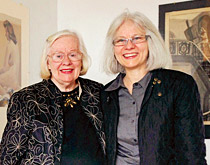
Although it's the Great Depression, the third-grader doesn't go hungry. Her dad, a mechanical engineer, lost his job. But he finds work playing the French horn and cornet, as well as making industrial soap for Pittsburgh Plate Glass, so his little girl, Eleanor, can do what little girls do-go to school. Eleanor's teacher discovers that the youngster has talent when it comes to drawing and recommends her for an art class that meets every Saturday. The class is taught by Carnegie Tech professor and sculptor Joseph Fitzpatrick and is held near the campus at the Carnegie Institute, which is less than 15 miles from Eleanor's home. Through the class work, Eleanor explores various types of art forms, ranging from sculpture to drawing to painting.
When the time comes to pick a college, the choice is easy. At Carnegie Tech, she can still live at home, resume studying with the university's art professors on a collegiate level, and follow in the legacy of her father, John Paul Wilson, a Tech alumnus.
Eleanor is just three months into her freshman year on December 7, 1941, when Pearl Harbor is bombed. Campus goes from bustling, students preparing for finals, to seemingly empty and directionless with just a few male classmates remaining on campus. Many of the young men immediately went off to war. "Campus life changed overnight," she says.
But campus life perseveres. "It was important to Dr. Readio, head of the department, that we continue on as normally as possible," she says. In addition to studio work, Eleanor sketches portraits of servicemen at the railroad station. "We usually had 30 minutes to sketch the fellows-sometimes a lot less-before their train would come," she says.
Despite being a commuter student, she takes advantage of campus life and is involved in numerous activities, including planning Kappa Kappa Gamma sorority events-"I loved Sing and Swing!"-serving as art editor of The Thistle, and working on the era's Facebook, a student handbook produced by Pi Delta Epsilon, a journalistic honorary society.
She is four years older than another student who would rise to international fame, Andy Warhol (A'49), and points out that both studied under the same "legendary" painting and design professors, including one in particular. "Andy Warhol got good ideas from Bob Lepper," she says. "He taught you to think and use your brain."
Like Warhol and other Tech classmates, she helps support herself through window display work at Pittsburgh department stores. After earning her undergraduate degree in 1945, she continues to live at home and takes a job at a local school district, teaching art to first graders all the way to seniors in high school. She also stays in touch with one particular college classmate, Jim Stoltz, who had given her his fraternity pin and even serenaded her with the Beta fraternity, "the highlight of college," says Eleanor.
One night in March of 1947, there is a knock on the front door. Eleanor's mother answers. It's her daughter's boyfriend. He enters the kitchen. Before Eleanor realizes what's happening, he asks for her hand in marriage. She instantaneously exclaims, "Yes!" He slips a hand-crafted silver ring on her finger just before a phone call brings them back to reality. Stoltz's mother is on the line, demanding that he return home immediately. "Jim had a high fever because of malaria," Eleanor explains. "He really shouldn't have been out of bed, but he just couldn't wait to give me the ring that Professor Clayter made."
She and Stoltz marry on September 20, 1947. Her husband, having resumed his studies after serving his country, earns his degree in 1948 and begins a career in engineering. Eleanor spends the next 60 years painting and sketching and working as an art teacher. She would eventually supervise the art departments for 10 elementary schools and start two children's art schools.
Her alma mater also kept her busy. She volunteered to make calls and encouraged classmates to return to campus for reunion weekends. She also donated to the university to help fund endeavors such as student scholarships. Her husband donated to the university as well, until his passing six years ago.
Throughout her teaching career, she encouraged students to go into the world, learn languages, and experiment with various art forms. Simply put, she is not a fan of coloring book art; rather, she believes in creating art.

Eleanor says she had many rewarding experiences as a teacher. But she is most proud that she passed along her love of art to one of her four daughters, Susan Stoltz, who is an artist and curator and has exhibited art and film internationally in venues from Sotheby's Parke-Bernet to the Moscow Film Festival. In fact, she served as curator of her mother's art show held at the Ellis Gallery last fall in Carnegie Mellon's College of Fine Arts. It was the first time a Carnegie Mellon graduate was invited to exhibit at the gallery, which normally features student artwork.
Eleanor's exhibit, "After Pearl Harbor," featured her student portfolio that recreated the World War II student era through an autobiographical work, combining art and history. Supplementing the exhibit were additional artworks, metal crafts, personal objects, and photos on loan from Eleanor's family. One of those items was a hand-sewn tartan plaid dress from 1941. "I didn't do much with sewing at the time, but I wanted something with that tartan plaid," she says. "I just love the plaid."
Eleanor, who lives in California, returned to campus during Homecoming for the exhibit. Afterwards, the drawings from her portfolio and other select memorabilia were placed as a collection in the university's archives, where they're available for reference and study.
Laurel Furlow, a former newspaper reporter, is the assistant director of on-campus programs in the Office of Alumni Relations.



